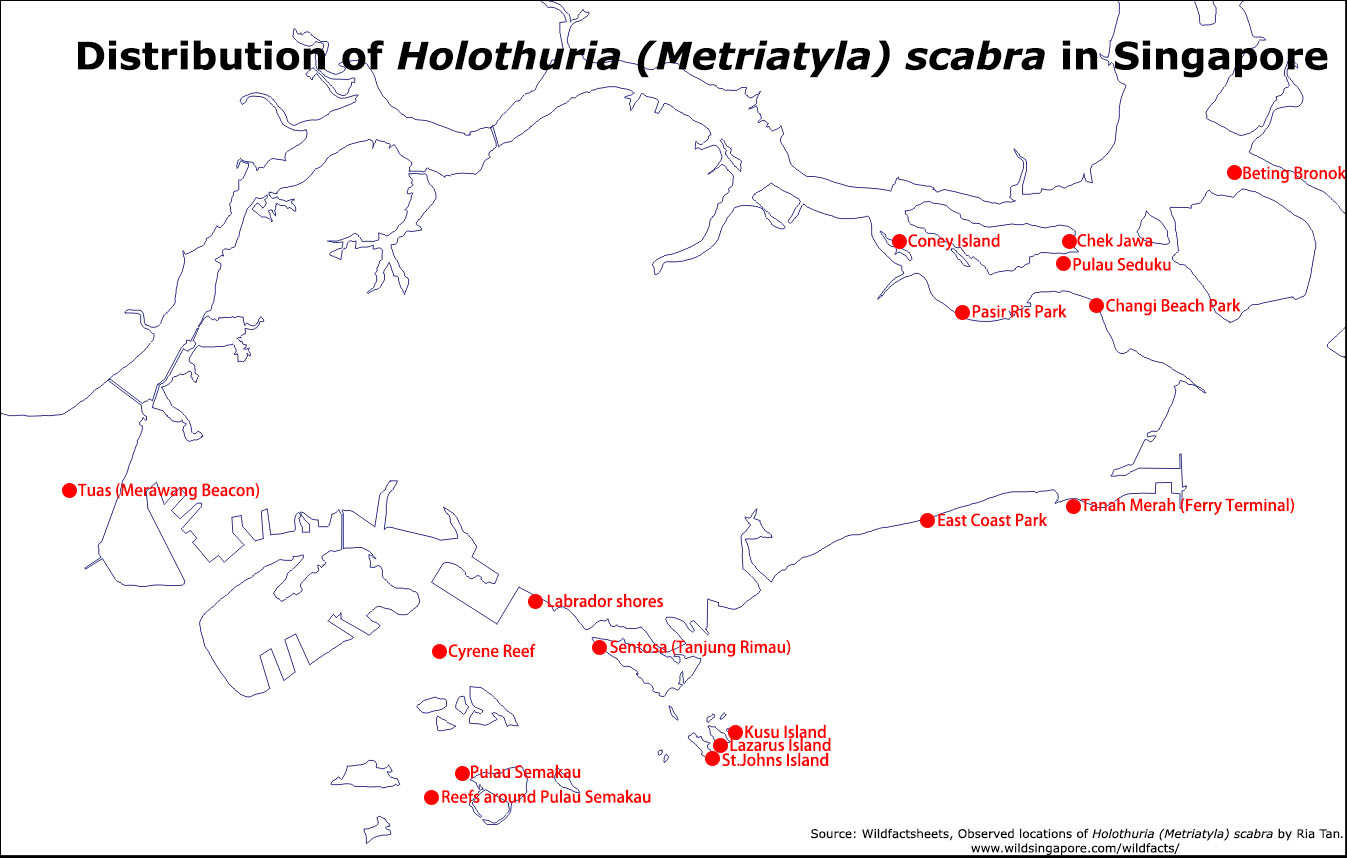Table of Contents
Holothuria (Metriatyla) scabra Jaeger, 1833
Sandfish Sea Cucumber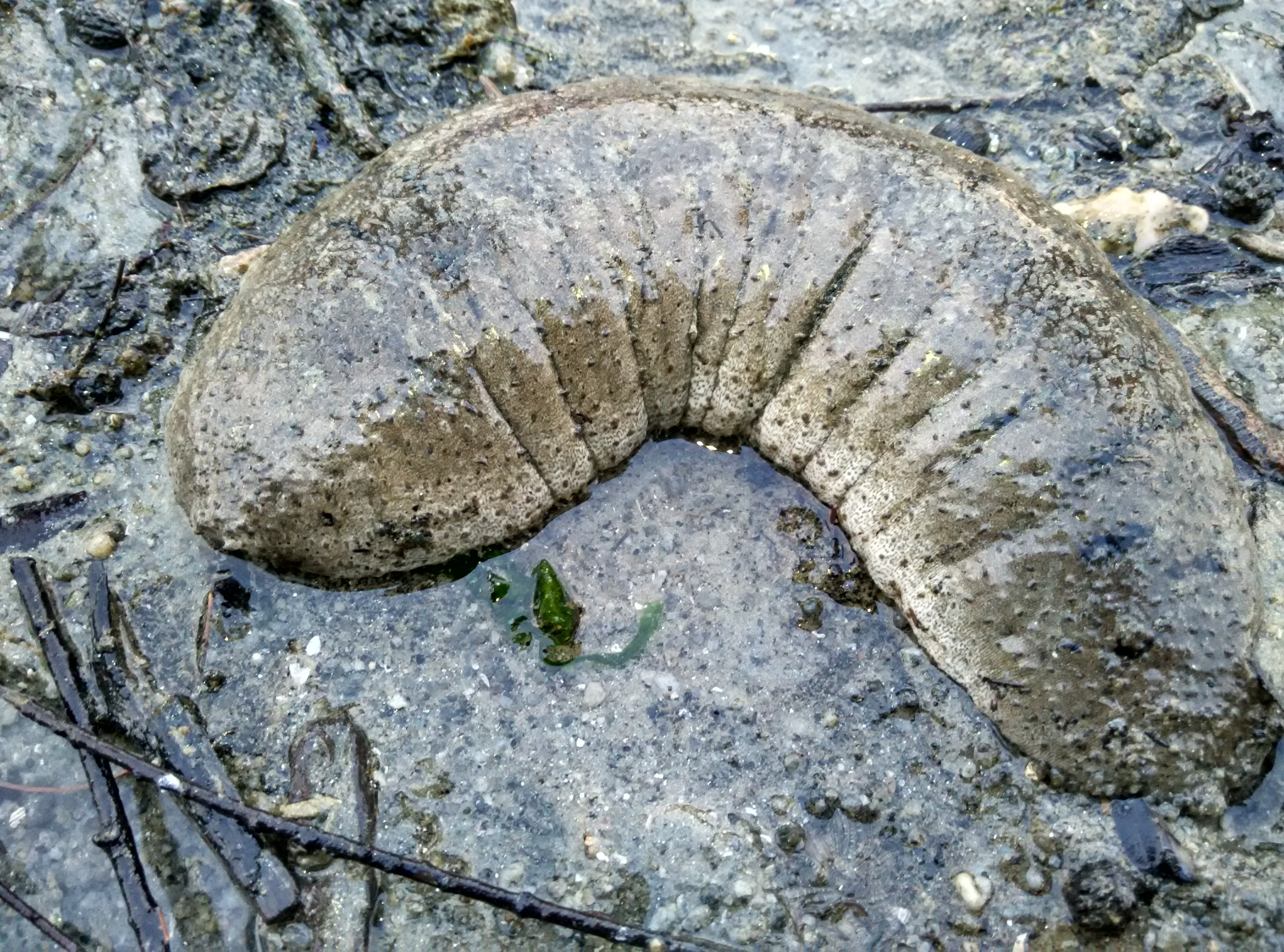 |
| Figure 1: Holothuria (Metriatyla) scabra seen at Coney Island, Singapore (Photo by Lin Yunian, 2016 [1]) |
I. More than a delicacy?
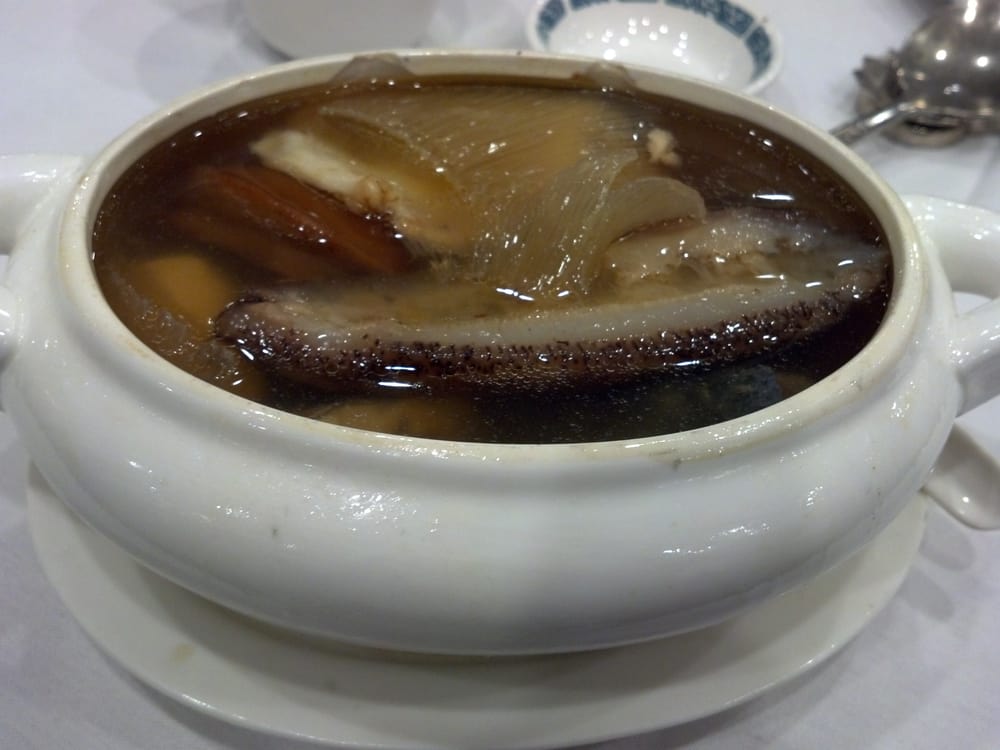 |
| Figure 2 Buddha's Delight Soup (Image owned by www.yelp.com [2], used in accordance to Fair Use guidelines) |
Indeed, Holothuria (Metriatyla) scabra, 糙海参, is prized by many, first and foremost, as a delicacy. It is known by a variety of names, as delicacy names – bêche-de-mer (in French), trepang (adapted from Indonesian – teripang), namako (in Japanese) and other common names, like Garlic Bread sea cucumber, Sandfish sea cucumber and Golden Sandfish sea cucumber [3,4]. Especially popular among the Chinese, Holothuria (Metriatyla) scabra, or colloquially referred together with a few other edible sea cucumber species as 秃参 (tu shen), is commonly used as an ingredient in renowned Chinese delicacy names like the “Buddha Jumps Over the Wall”, “Shark fin soup” or served with abalone. However, few people know it more than a mere food product; are you one of them?
In fact, the sandfish sea cucumbers have been heavily overfished in order to satiate our taste buds and bellies. Listed under the IUCN Red List and Singapore Red Data Book, it is pertinent that we should reconsider putting these sea cucumbers on our plates for dinner. The sandfish sea cucumber is really more than meets the “tummy”!
II. Sea cucumbers of Singapore: how to identify the Holothuria (Metriatyla) scabra?
There are at least 23 species of sea cucumbers in Singapore waters [5], of which seven species of sea cucumbers belong to the genus Holothuria. However, as of latest studies published made by Ong & Wong (2015) based on the Comprehensive Marine Biodiversity Survey (CMBS), there are at least 30 species of sea cucumbers now found in Singapore waters[6]. Furthermore, the CMBS study did not include sites from our Southern shores [6]; hence it is highly plausible that more sea cucumber species are yet to be found [7]. Note that there is also a large number of undescribed sea cucumber species observed on local intertidal wildlife blogs – with at least 15 undescribed species [8,9].
The Holothuria (Metriatyla) scabra is distinctive in a few ways. The most obvious way to identify this sea cucumber species is to note for its greatly distinct **dorsal** and **ventral** sides. Firstly, while the dorsal side can vary in color, from off-whitish to greyish or dark brown, occasionally with darker transverse line markings, the ventral side is consistently lighter in shade, generally whitish[3,10]. Secondly, its ventral side is generally flat and its dorsal side is rounded, thus its cross section has a somewhat semi-circular shape [3]; its rounded cross section width is generally consistent towards both ends, giving rise to two rather blunt ends.
 |
| Figure 3: Variation in ventral side coloration found in Holothuria (Metriatyla) scabra. (Images owned by Ria Tan [3]) |
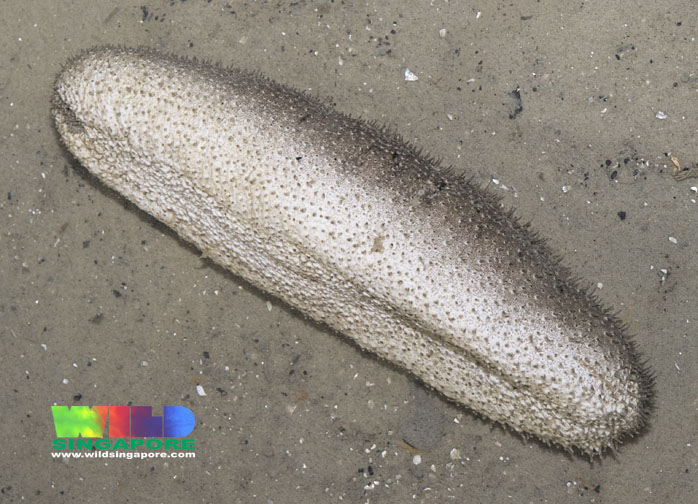 |
| Figure 4: Underside of Holothuria (Metriatyla) scabra being consistently lighter in colour. Underside is also observed to be flat. (Image owned by Ria Tan [3]) |
Another distinctive morphological feature is that the Holothuria (Metriatyla) scabra has its mouth on the ventral side of its body [10]; about 20 short and stout tentacles are found around its mouth. Short tube feet are also found spread over the body of the Holothuria (Metriatyla) scabra. This sea cucumber is also larger species as compared to the other sea cucumber species in the Singapore waters, with its adult measuring about 20-30cm in length ( and can grow up to 35cm) [3, 10].
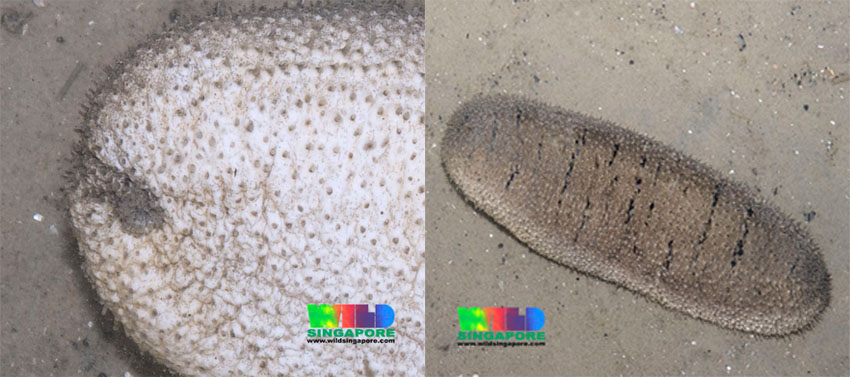 |
| Figure 5: (left) Mouth located on the ventral side of Holothuria (Metriatyla) scabra; (right) Short tube feet all over its body. (Images owned by Ria Tan[3]) |
One possibly similar species of sea cucumber, the Ashy Pink sea cucumber, Holothuria (Stauropora) fuscocinerea also has a distinct and contrasting dorsal and ventral side, some even having similar colourations and dark line markings, making it difficult to differentiate.
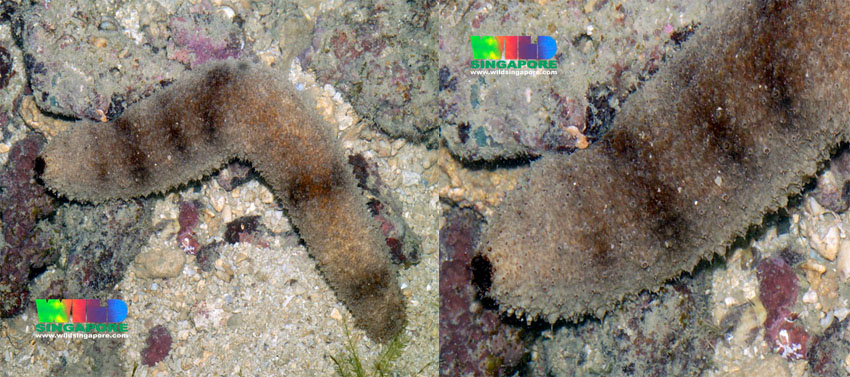 |
| Figure 6: (left) Holothuria (Stauropora) fuscocinerea; (right) Closer look at darker brown colouration on anus of Holothuria (Stauropora) fuscocinerea (Images owned by Ria Tan [9]) |
One simple way to distinguish the two is to look for the colouration of the anus of both sea cucumbers. The anus of the Holothuria (Stauropora) fuscocinerea has a striking dark brown coloration while the anus of Holothuria (Metriatyla) scabra does not. Also, the transverse markings are also less well defined and more diffused as compared to the Holothuria (Metriatyla) scabra and the ends of the Holothuria (Stauropora) fuscocinerea are relatively more pointed. Holothuria (Metriatyla) scabra do not eviscerate spontaneously as do the Holothuria (Stauropora) fuscocinerea too.
III. Habitat and Distribution
a) Global: where can I find it in the world?
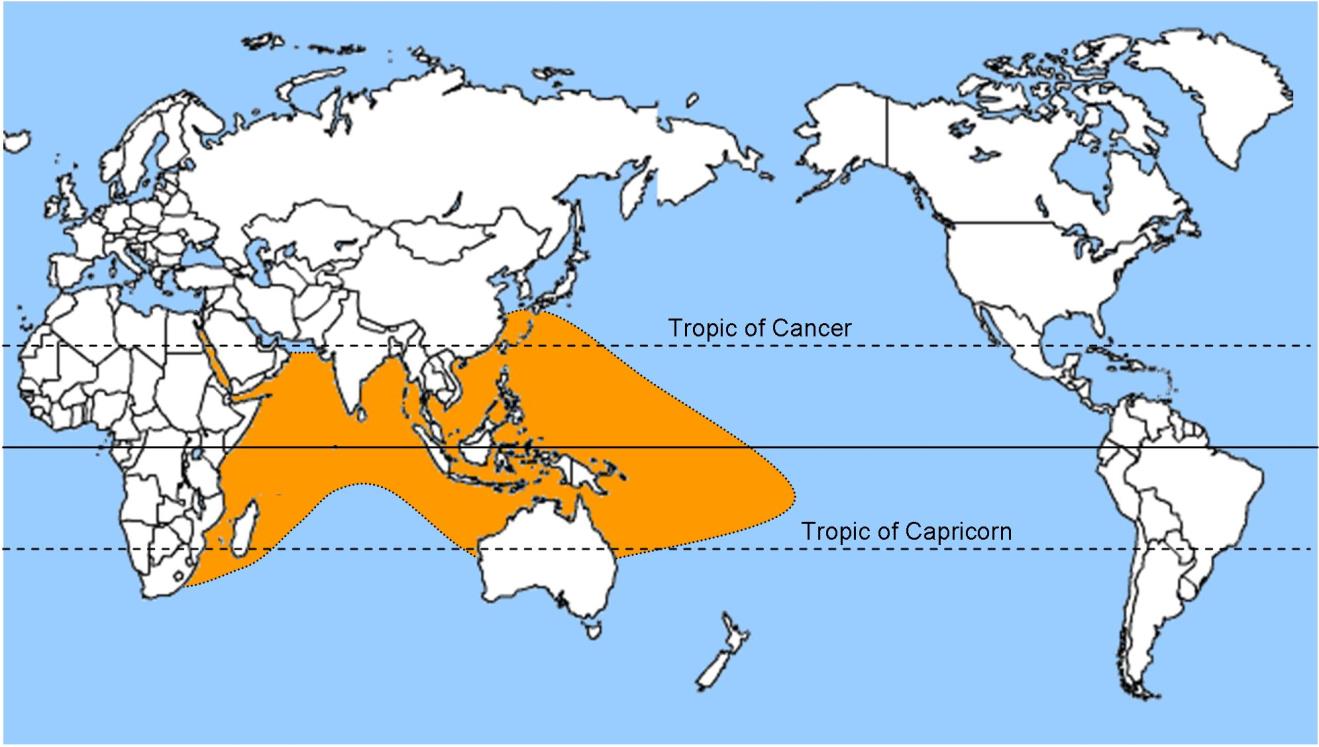 |
| Figure 7: Distribution of the Holothuria (Metriatyla) scabra worldwide (Image owned by Bell et al. [12], used with permission from author) |
Being a tropical sea cucumber species, the Holothuria (Metriatyla) scabra is widely distributed in the old world tropics, latitudes 30 degrees North and 30 degrees South, from near the tip of South Africa to islands situated on the South Pacific Ocean, east of Australia; like Vanuatu and Cook Islands (too small for visualisation on the map above) [4].
b) Local: it's found in Singapore??!
Holothuria (Metriatyla) scabra has also a sizeable distribution in Singapore waters, being spotted in at least 17 locations. The map above shows that it is generally found in our northeastern and southern shores.
c) Habitat: home sweet home
This species of sea cucumber is found in calmer waters, at sheltered coastal areas like bays, lagoons and shores with muddy or silty substrates [4]. It is commonly spotted at depths below 10m though there are few records of observation at 25m [4, 10]. Though found in some reef areas, Holothuria (Metriatyla) scabra is generally found in intertidal seagrass beds [4]. While they feed on muddy and silty substrates [4], studies made by Mercier et al. (2000) have revealed that larvae of Holothuria (Metriatyla) scabra preferentially settles on seagrass beds [14]; in fact, their larvae are found to delay metamorphosis if no suitable seagrass substrates can be located [14].
This is congruent to observations made by local wildlife groups [3,9] , where Holothuria (Metriatyla) scabra are found on local seagrass beds– including Thalassia hemprichii (sickle seagrass), Cymodocea spp. (needle seagrasses), Halophila spp. (spoon seagrasses) and Enhalus acoroides (tape seagrass) other seagrass species.
IV. Biology
a) Behavior: just keep digging...
The Holothuria (Metriatyla) scabra is usually spotted partially or fully buried in the sandy or muddy substrates [3, 10]. Studies by Mercier et al. (1999) reveal that the burrowing behaviour of this species sea cucumber is closely related to environmental factors present [15]. As small juveniles, their burrowing behaviour is most positively related to increasing light intensities [15]. As they grow into adults, their burrowing behaviour becomes more positively related to decreasing temperatures and salinity as well [15, 16] It is also found that adult Holothuria (Metriatyla) scabra observes a **diel** burrowing cycle – they generally burrow in the day and are exposed at night [16]. When burrowed, the Holothuria (Metriatyla) scabra do not move or feed; conversely, their movement and feeding periods coincide with their exposed periods [15].
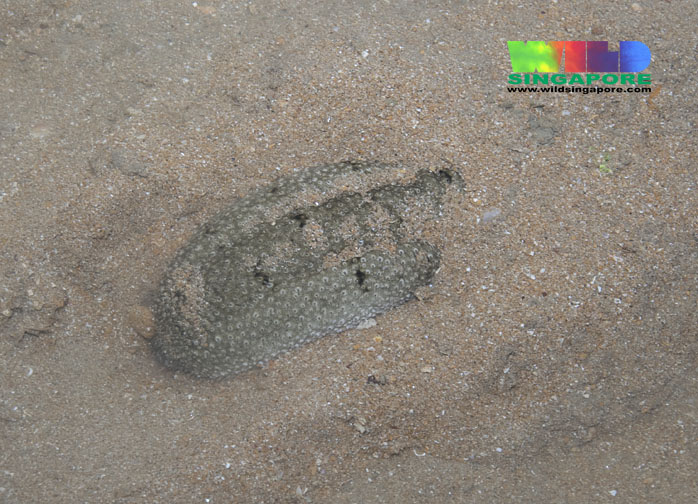 |
| Figure 9: A partially burrowed Holothuria (Metriatyla) scabra (image owned by Ria Tan [3]) |
b) Diet: food for thought...
The adult Holothuria (Metriatyla) scabra is a benthic detritivore; using its grey **peltate** feeding tube feet (looks like tentacles), it sieves through the sediment substrate it ingests to feed on the organic matter present [3, 10]. Such organic matter includes minute particles like tiny aquatic organisms - like copepods and diatoms, waste and algae [17]. As such, Holothuria (Metriatyla) scabra, like many other sea cucumber species, observes an omnivorous diet [17].
Timelapse video of Holothuria (Metriatyla) scabra feeding [18].
b) Reproduction and life cycle: a 'cloudy' reunion underwater
Due to the high economic value of this sea cucumber, its reproduction process is extensively studied. This sea cucumber species is **dioecious** – each individual is either a male or female [19]; however, it is almost impossible to tell this difference except for when the **gonopores** are exposed during spawning [19]. According to studies conducted to observe mature gonopores between male and female Holothuria (Metriatyla) scabra, the mature female **gonads** were reported with two varying forms – either translucent, or brown tubules of even length and thickness with little white spots (oocytes), while the mature male gonads are observed to have lengthy white beaded filaments of even length and thickness [19].
When ready for spawning, individuals of both sexes raises the anterior side of their body and commences a certain swaying fashion to spread the **gametes** [20]. Albeit generally hard to perceive, Conand (1993) has expressed that the sperms released by male individuals form a more noticeable white string or cloud than the translucent or pale yellow spherical white **oocytes** released by female individuals [20].
Male Holothuria (Metriatyla) scabra spawning under heat shock in a hatchery [21].
Fertilisation occurs in the water column when the released oocytes and sperms meets and fuses; this is observed to happen both at the water surface and on the sea bed [22, 23]. After fertilisation, the larvae now undergoes a three step development – from an **auricularia** form feeding on plankton to a non-feeding **doliolariae** form, and will finally settle in a **pentactulae** form. Battaglene (1999) has observed that the Holothuria (Metriatyla) scabra takes 14 days to develop into juveniles on 5-10mm in culture conditions [24].
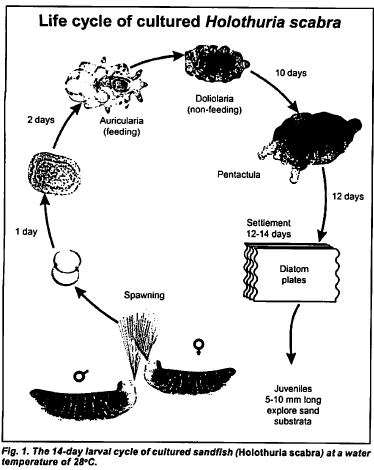 |
| Figure 10: Larval cycle of Holothuria (Metriatyla) scabra (Image owned by Battaglene [24], used with permission from author) |
d) Role in ecosystem: lend a helping hand!
Adult Holothuria (Metriatyla) scabra ingests large amounts of sandy or muddy substrate of which it sieves through for organic material. Sand or mud that has been processed through its gut will then be excreted, helping in mineralisation or nutrient upcycling processes [25]. This process of disturbing the sediment surface by the sea cucumbers is known as **bioturbation**.
Bioturbators like sea cucumbers are essential in keeping marine environments from having too high levels of organic material on their seabed [25]; in turn, they are possibly vital in preventing anoxic benthic environments. Their unique ecosystem functions are also tapped upon in keeping marine benthic environments of aquaculture farms from being overloaded with nutrients [26].
e) Relationship with other species: friends, foes and those that don't pay rent
Larval forms of Holothuria (Metriatyla) scabra are being preyed upon by copepods, amphipods and ciliates [14, 27]. In an experiment to test predation, small juveniles of 20-70mm released on sand near coral reefs are predated by a range of fish species (includes Balistidae, Lethrinidae and Nymipteridae); the same experiment done on seagrass beds observed no predation. Adults were not observed to have any predators [28].
It is generally well known that adult Holothuria (Metriatyla) scabra has many associations with various other organisms – including gastropods, crustaceans, worms and fish [19]. These organisms largely inhabit the **cloaca**, **coelom** or respiratory trees of the adult Holothuria (Metriatyla) scabra. One such example found in Singapore is the symbiotic relationship between pea crabs (Pinnotheres spp.) and the Holothuria (Metriatyla) scabra [19, 29]. Most of such symbiotic relationships pose no harm to this sea cucumber; however, some of them have been shown to cause deterioration of respiratory trees or reduce gonad sizes [29].
V. Threats and Conservation Issues
a) The highly valued sea cucumber
Renowned as a food item and for its acclaimed medicinal qualities, sea cucumbers are highly sought after. But more than that, dried sea cucumbers are expensive – selling from US$10-US$600 per kilograms [30, 31]; in fact, the sandfish sea cucumber fetches the highest price among all the tropical and sub-tropical species [31]. Thus they are important source of income to poor coastal communities located in the Asia Pacific – they are even dubbed “economic savior(s)” [31, 32]. To meet the high demand for sandfish sea cucumbers, they are bred in aquaculture as well [31]. The sandfish sea cucumber is regarded by breeders as an excellent choice for farming due to its ability to adapt to altered environments, such as tolerating salinity fluctuations [31]. Some researchers are hopeful towards the recovery of wild populations of Holothuria (Metriatyla) scabra through the introduction of more of such pond aquaculture farms [33, 34]; however whether it would eventually aid in its recovery in numbers still remains uncertain. Till it's well reported, we should all keep a watchful eye and play a part by reducing our consumption of these sea cucumbers!
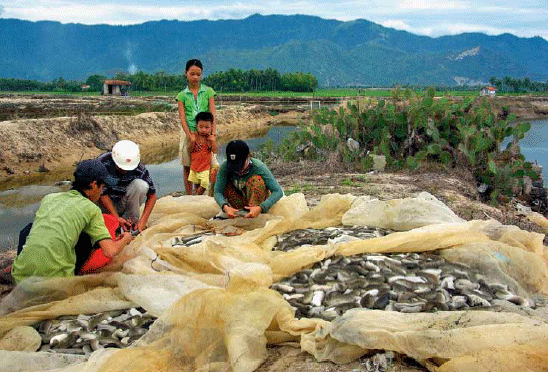 |
| Figure 11: Gutting sea cucumbers harvested from a commercial pond prior to drying for export in Van Anh, Vietnam. (Image owned by Stephen Purcell [33], used in accordance to Fair Use Guidelines) |
b) Global: struck on all sides...
As aforementioned, the Holothuria (Metriatyla) scabra is a popular food product; hence it is unsurprising that overexploitation issues are rampant. According to Hamel et al. (2013), more than half of the Holothuria (Metriatyla) scabra local populations have been driven to less than 10% of its original numbers [4]; the past half a century has seen about half of its whole population disappear [4]. Under the International Union for Conservation of Nature (IUCN) Red List, it is currently listed as Endangered.
c) Local: no...not our natural shores!
According the Singapore Red Data Book, the Holothuria (Metriatyla) scabra is listed as Vulnerable. Though aquaculture of the sandfish cucumber is common, the population number of the Holothuria (Metriatyla) scabra in Singapore is too low to support such farming purposes. The biggest threats faced by the Holothuria (Metriatyla) scabra in Singapore are coastal development [35], such as land reclamation that devastates their habitats – seagrass beds. Davison et al. (2008) suggests for the implementation of Marine Protected Areas to protect intertidal sandy habitats that are home to this vulnerable species.
VI. Taxonomy and Systematics
a) Taxonavigation
According to the World Register of Marine Species [36], The Holothuria (Metriatyla) scabra is taxonomically classified as such (rank names are omitted):
Animalia
Echinodermata
Echinozoa
Holothuroidea
Aspidochirotida
Holothuriidae
Holothuria
Holothuria (Metriatyla)
Holothuria (Metriatyla) scabra
b) Original description and taxonomic history
The original description of Holothuria scabra is found in the publication title “De Holothuriis” in a Spanish language scientific magazine, Turici, by Jaeger in 1833 [37, 38]. Unfortunately, there is no pictorial evidence of the original description easily accessible on online journal platforms or libraries. Though it is unknown about what kind of type was preserved (specimen, description or pictorial etc.; holotypes or not), based on Rowe’s reference to it while describing the subgenus Metriatyla, as shown in the further paragraphs, there is a possibility that a good holotype specimen was retained. However, it is worthy to note that a neotype for Holothuria (Metriatyla) scabra was founded in 2009, likely being a replacement for the holotype [39].
Following Jaeger in 1833, there were instances of further classifications and description events of the same species under different names that are later synonymised. The following names are both referenced from some key publications [19, 38]:
Holothuria (Holothuria) scabra Jaeger, 1833
Holothuria (Metriatyla) fuligina Cherbonnier, 1988
Holothuria (Microthele) tigris Brandt, 1835
Holothuria albida Savigny in Selenka, 1867
Holothuria gallensis Pearson, 1903
Holothuria saecularis Bell, 1887
The further classification of Holothuria scabra into subgenus Metriatyla by Rowe, 1969, is the accepted name by the World Register of Marine Species [38]. The subgenus Metriatyla used the Holothuria scabra Jaeger, 1833 for its type species in the subgenus [40].
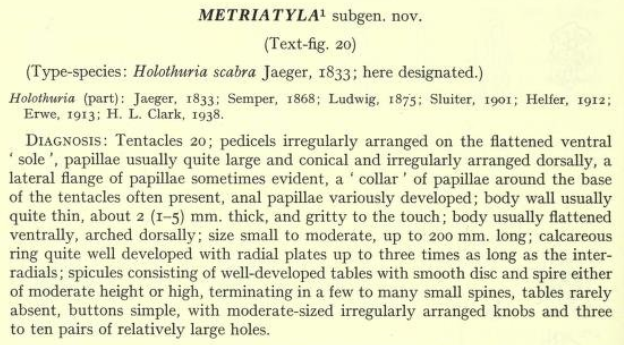 |
| Figure 12: Description of subgenus Metriatyla using Holothuria scabra Jaeger, 1833 as a type species; diagnosis of subgenus of Metriatyla [40] – used in accordance to Fair Use Guidelines. |
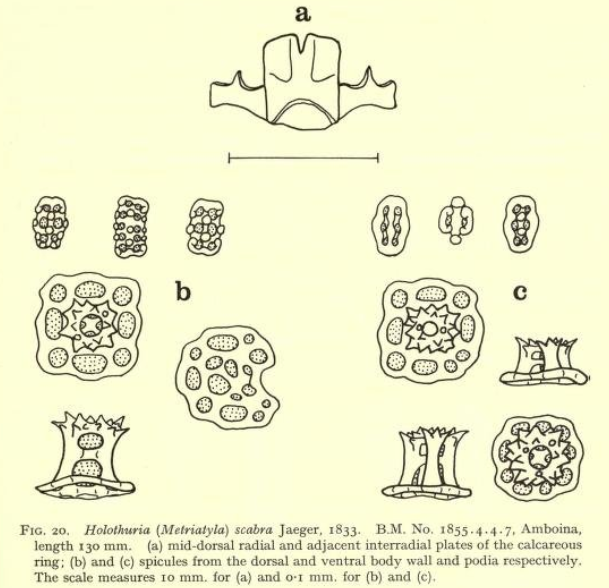 |
| Figure 13: Illustration of calcareous plates and spicules found in individuals in subgenus of Metriatyla [40] used in accordance to Fair Use Guidelines. |
More recently, a morphologically similar species that was once regarded as a subspecies, the Holothuria (Metriatyla) scabra var. versicolor Conand, 1986, is now reclassified into a new species, Holothuria (Metriatyla) lessoni; it is described in the paper written by Massin et al. (2009) [39, 41]. Massin et al. (2009) mentioned that the Holothuria (Metriatyla) scabra var. versicolor can hybridize with the Holothuria (Metriatyla) scabra; however, they stood their ground for splitting using differences found in molecular studies, skeletal elements and external morphologies. Such a species delimitation concept veers away from biological species concepts which require reproductive isolation; the species delimitation concept used here seems to draw similarity with the phylogenetic species concept by Wheeler and Platnick (2000) instead, which focuses on describing species through their unique combination of fixed character states.
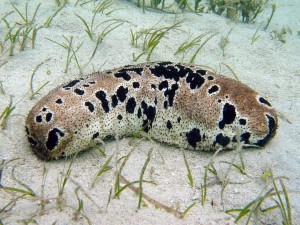 |
| Figure 14: The Holothuria (Metriatyla) lessoni can look similar to the Holothuria (Metriatyla) scabra (image owned by Steven Purcell, used in accordance to Fair Use Guidelines [42]) |
VII. Phylogeny
Phylogenetic studies have been made to investigate the relationships between sea cucumber individuals belonging to the genus Holothuria. One such study is made by Kamarudin et al. (2016), which analysed 16S mitochondrial rRNA of 88 individuals from genus Holothuria using **maximum parsimony** [43]. This was done by PAUP* (version 4.0b10) program with 1000 replicates.
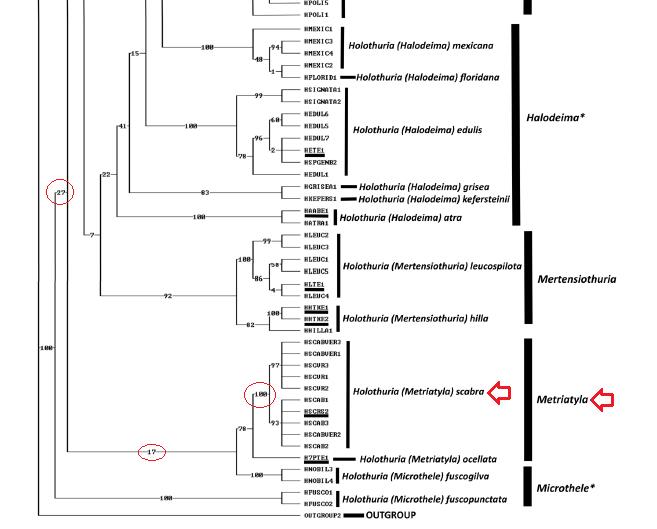 |
| Figure 15: Cropped image Maximum parsimony tree done on 88 individuals from genus Holothuria (image owned by Kamarudin et al. (2016) [43] pending approval; annontated by Lin Yunian) |
The consensus maximum parsimony tree, we can see that the bootstrap value for the node that splits to include all the Holothuria (Metriatyla) scabra individuals is 100, which means the node is highly stable; thus supporting it as a species. However, its positioning and relationship with other Holothuria spp. can be further ascertained, as seen from the low bootstrap values stated on the earlier nodes (for example the earlier nodes that scored bootstraps values of 17 and 27).
VIII. Other Resources
Sea Life Base information sheet on Holothuria scabra - http://www.sealifebase.org/summary/Holothuria-scabra.html
WildSingapore information sheet on Holothuria scabra - http://www.wildsingapore.com/wildfacts/echinodermata/holothuroidea/scabra.htm
IUCN Red list on Holothuria scabra - http://www.iucnredlist.org/details/180257/
IX. Glossary
Ventral – under side of the animal
Dorsal – upper side of the animal
Diel – involving a period of 24 hours
Peltate – shield shape; circular shape
Gonopore – genital pore in many invertebrates
Gonad – organ that produces gametes
Gametes – female or male germ cells; when both cells meet they undergo sexual fertilisation
Oocytes – a cell in an ovary which can undergo meiosis to form an ovum
Auricularia – a larval form that has ciliated arms for swimming. it also has a mouth, gut and an anus.
Doliolariae – the stage after Auricularia; this larval form has a barrel like body with 5 ciliated bands around it
Pentactulae – the stage after Doliolariae; this larval form has five tentacles
Bioturbation – the disturbance of sedimentary deposits by living organisms
Cloaca – cavity at the end of digestive tract that release both excretory and genital products
Coelom – principal cavity in most animals, located between the intestinal canal and body wall
Maximum Parsimony - A principle in Cladistics that searches for the phylogenetic tree having the minimum number of character state changes
X. References
[1] Holothuria (Metriatyla) scabra seen at Coney Island, Singapore, by Lin Yunian, July 2016. (Author’s own work)
[2] “Buddha’s Delight Soup”, by Priscilla (hosted on Yelp), Feb 2014. URL:https://www.yelp.com/biz_photos/mayflower-restaurant-milpitas?select=XPW0o4_kjZpN_lerRQ8-MA (Accessed on 6 Nov 2015)
[3] “Garlic Bread Sea Cucumber”, by Ria Tan, Oct 2016. URL: http://www.wildsingapore.com/wildfacts/echinodermata/holothuroidea/scabra.htm (Accessed on 6 Nov 2015)
[4] Hamel, J.-F., Mercier, A., Conand, C., Purcell, S., Toral-Granda, T.-G. & Gamboa, R., 2013. Holothuria scabra. The IUCN Red List of Threatened Species 2013. URL:http://dx.doi.org/10.2305/IUCN.UK.2013-1.RLTS.T180257A1606648.en (Accessed on 6 Nov 2016)
[5] Ng, P.K.L., Corlett, R.T. & Tan, H.T.W, 2011. Singapore Biodiversity – An Encyclopaedia of the Natural Environment and Sustainable Development. Editions Didier Millet, Singapore. 552 pp.
[6] Ong, J.Y. & Wong, H.P.-S, 2015. Sea Cucumbers (Echinodermata: Holothuroidea) from the Johor Straits, Singapore. Raffles Bulletin of Zoology, 31:273-291.
[7] Teo, S., Ng C.S.L. & Loh, K.S., 2010. New record of a sea cucumber, Holothuria (Stauropora) Fuscocinerea Jaeger, 1833 (Holothuroidea: Aspidochirotida: Holothuriidae) in Singapore. Nature in Singapore, 3:133-137.
[8] “Sea cucumbers: Class Holothuroidea”, by Ria Tan, Dec 15. URL: http://www.wildsingapore.com/wildfacts/echinodermata/holothuroidea/holothuroidea.htm (Accessed on 6 Nov 2016)
[9] “Sea Cucumbers (Phylum Echinodermata: Class Holothuroidea) of Singapore”, by Ron Yeo, April 2012. URL:http://tidechaser.blogspot.sg/2012/04/sea-cucumbers-holothuroidea-of.html (Accessed on 6 Nov 2016)
[10] “Holothuria scabra Jaeger, 1833 : sandfish”, by SeaLifeBase, Aug 2012. URL: http://www.sealifebase.org/summary/Holothuria-scabra.html (Accessed on 6 Nov 2016)
[11] “Ashy Pink sea cucumber: Holothuria fuscocinerea”, by Ria Tan, Oct 2016. URL: http://www.wildsingapore.com/wildfacts/echinodermata/holothuroidea/fuscocinerea.htm (Accessed on 6 Nov 2016)
[12] Bell, J.D., Purcell S.W. & Nash, W.J., 2008. Restoring small-scale fisheries for tropical sea cucumbers. Ocean and Coastal Management. 51:589-593.
[13] “Drawing map shapes with rgdal”, by Yoke Keong, n.d.. URL: http://yokekeong.com/drawing-map-shapes-with-rgdal/ (Accessed on 6 Nov 2016)
[14] Mercier, A., Stephen, C.B., Hamel, J.-F., 2000. Settlement preferences and early migration of the tropical sea cucumber Holothuria scabra. Journal of Experimental Marine Biology and Ecology, 249:89-110.
[15] Mercier, Stephen, Jean-Francois, 1999. Daily burrowing cycle and feeding activity of juvenile sea cucumbers Holothuria scabra in response to environmental factors. Journal of Experimental Marine Biology and Ecology, 239:125-156.
[16] Wolkenhauer, S.M., 2008. Burying and Feeding activity of adult Holothuria scabra (Echinodermata: Holothuroidea) in a controlled environment. SPC Beche de Mer Information Bulletin, 27:25-27.
[17] “Sea Cucumber: Holothuroidea”, by National Geographic, n.d.. URL: http://animals.nationalgeographic.com/animals/invertebrates/sea-cucumber/ (Accessed on 6 Nov 2016)
[18] “Timelapse Holothuria scabra Feeding” by Madison Loos. Madison Loos Youtube Channel, 2 June 2015, URL: https://www.youtube.com/watch?v=TQdUuO-Tx60 (Accessed on 6 Nov 2016)
[19] Hamel, J.-F., Conand, C., Pawson, D.L. & Mercier, A., 2001. The Sea Cucumber Holothuria scabra (Holothuroidea: Echinodermata): Its Biology and Exploitation as Beche-de-Mer. Advances in Marine Biology, 41:129-223.
[20] Conand, D., 1993. Reproductive biology of the holothurians from the major communities of the New Caledonian Lagoon. Marine Biology, 116: 439-450.
[21] “Spawning Male Sandfish Sea Cucumber (Holothuria scabra)” by khensthoth. Khensthoth Youtube Channel, 1 Jul 2013, URL: https://www.youtube.com/watch?v=Nkntw8SzopI (Accessed on 2 Nov 2016)
[22] James, P.S.B.R., 1996. Technologies and potential or sea farming in India, part II. Aquaculture Magazine June, 30-34.
[23] James D. B., 1998. Research, Conservation and Management of edible holothurians and their impace on the beche-de-mer industry. Central Marine Fisheries Research Institute, Special Publication 40: 97-98.
[24] Battaglene, S.C. (1999). Culture of Tropical Sea Cucumbers for Stock Restoration and Enhancement. Naga, The ICLARM Quarterly, 22(4):4-11.
[25] Mactavish, T., Stenton-Dozey, J., Vopel, K., Savage, C., 2012. Deposit-Feeding Sea Cucumbers Enhance Mineralization and Nutrient Cycling in Organically-Enriched Coastal Sediments. PLoS ONE 7(11).
[26] Slater, M.J., & Carton, A.G., 2009. Effect of sea cucumber (Australostichopus mollis) grazing on coastal sediments impacted by mussel farm deposition. Marine Pollution Bulletin, 58:1123-1129.
[27] James, P.S.B.R. & James, D.B., 1994. Management of the beche-de-mer industry in India. In "The Proceedings of the National Workshop on Beche-demer", pp. 17-22. Central Marine Fisheries Research Institute, Indian Council of Agricultural Research, Cochin, India.
[28] Mercier, A., Battaglene, S.C., Hamel, J.-F., 2000. Periodic movement, recruitment and size-related distribution of the sea cucumber Holothuria scabra in Solomon Islands. Hydrobiologia, 440: 81-100.
[29] Hamel, J.-F., Ng, P.K.L., Mercier, A., 1999. Life Cycle of Pea Crab Pinnotheres halingi sp.nov., an obligate symbiont of the sea cucumber Holothuria scabra Jaeger. OPHELIA, 50(3): 149-175.
[30] “Sea cucumbers are so popular in Asia they face extinction”, by The Conversation, March 2014. URL: http://theconversation.com/sea-cucumbers-are-so-popular-in-asia-they-face-extinction-24011 (Accessed on 6 Nov 2016)
[31] Tuwo, A., Tresnati, J. & Saharuddin, 2012. Analysis of growth of sandfish Holothuria scabra cultures at different cultivated habitat. In “The Proceedings of the 2nd Annual International Conference Sylah Kuala University 2012 & The 8th IMT-GT Uninet Biosciences Conference”, 2(1): 17-21. Faculty of Marine Science and Fisheries, Hasanuddin University, Banda Aceh.
[32] “Sea cucumbers: an economic savior”, by CGIAR, October 2011. URL: http://www.cgiar.org/consortium-news/sea-cucumbers-an-economic-savior/ (Accessed on 6 Nov 2016)
[33] “Sea Cucumber Ranching Shows Promise”, by TheFishSite, March 2012. URL: http://www.thefishsite.com/articles/1324/sea-cucumber-ranching-shows-promise/ (Accessed on 6 Nov 2016)
[34] Robinson, G., 2013. A Bright Future for Sandfish Aquaculture. World Aquaculture, 18-24.
[35] Davison, G.W.H., Ng, P.K.L. & Chew, H.H., 2008. The Singapore Red Data Book: Threatened Plants & Animals of Singapore. Nature Society (Singapore), Singapore. 285 pp.
[36] Paulay, G., 2015a. Holothuria (Metriatyla) scabra Jaeger, 1833. URL: World Register of Marine Species, http://www.marinespecies.org/aphia.php?p=taxdetails&id=210813 (Accessed on 6 Nov 2016)
[37] Jaeger, G.F., 1833. De Holothuriis. Turici. 40 pp.
[38] Paulay, G., 2015b. Holothuria (Holothuria) scabra Jaeger, 1833. URL: World Register of Marine Species,. http://www.marinespecies.org/aphia.php?p=taxdetails&id=732203 (Accessed on 6 Nov 2016)
[39] Massin, C., Uthicke, S., Purcell, S.W., Rowe, F.W.E. & Samyn, Y., 2009. Taxonomy of the heavily exploited Indo-Pacific sandfish complex (Echinodermata: Holothuriidae). Zoology Journal of the Linnean Society, 155(1): 40-59.
[40] Rowe, F.W.E., 1969. A review of the family Holothuriidae (Holothurioidea: Aspidochirotida). Bulletin of the British Museum (Nature History). Zoology.18(4): 119-170
[41] Paulay, G., 2015c. Holothuria (Metriatyla) lessoni Massin, Uthicke, Purcell, Rowe & Samyn, 2009. URL: World Register of Marine Species, http://www.marinespecies.org/aphia.php?p=taxdetails&id=529028 (Accessed 6 Nov 2016)
[42] “Extinction threat for sea cucumbers” , by DiscoverSCU, March 2014. URL: http://discover.scu.edu.au/2014-03-march/extinction-threat-as-sea-cucumbers-exploited-as-luxury-seafood/ (Accessed 6 Nov 2016)
[43] Kamarudin, K.R., Rehan, A.M., Hashim, R., Usup, G., Rehan, M.M., 2016. Phylogentic Relationships within the Genus Holothuria Inferred from 16S Mitochondrial rRNA Gene Sequences. Sains Malaysiana 45(7): 1079-1087.
